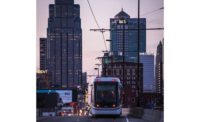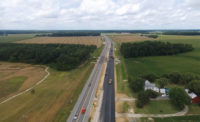Transportation infrastructure stakeholders say it’s a good time to be in the business, despite myriad challenges, and they are holding out hope for bipartisan agreements on federal funding and regulatory reform.
The backlog of construction projects “is as healthy as it’s ever been,” said Greg Kelly, president and CEO of WSP USA. Kelly spoke on a panel at the national convention of the American Road & Transportation Builders Association, held in New York City this month.
Bob Alger, president and CEO of Lane Industries, and new ARTBA chairman, said that the contractor could bid $100 billion in work in 12 states over the next three years. Addressing workforce challenges and diversity, he said: “We need a culture change—not just old white men building stuff.”
Kelly concurred, noting that the industry should attract more women by offering better options for work flexibility and maternity leave.
ARTBA formalized a commitment to such efforts at the convention, holding all-women leadership panels and award presentations and signing a memorandum of understanding with the Women’s Transportation Seminar.
The convention also marked the retirement of longtime leader Pete Ruane, who warned that “the job is not done” regarding a long-term federal funding solution. Although Congress and the Trump administration reached a two-year budget agreement calling for at least $10 billion a year in supplemental investment, the current highway trust fund shortfall of $14 billion will increase to $19 billion in 2020, noted David Bauer, executive vice president of advocacy with ARTBA.
Nick Goldstein, ARTBA vice president of regulatory and legal issues, noted that various regulatory reforms have been, or may be, enacted. Key changes include an agreement by federal agencies to streamline environmental reviews for major projects to an average of two years, repeal of a rule requiring federal contractors bidding on projects of $50 million or more to disclose various workplace health and safety violations, and repeal of a rule withholding federal funds from counties not meeting Clean Air Act standards for six pollutants.
Pending reforms that ARTBA says would benefit the industry include withdrawal of a rule that prohibits use of patented or proprietary products on federally funded highway and bridge projects and exempting construction machinery operators from an hours-of-service rule limiting motor carrier driver time.
|
Related Article |
Resilience and Technology
The convention also addressed resilience in infrastructure. Ryan Prime, sustainability director for Skanska USA Civil, highlighted flood mitigation elements being built into the $4-billion Terminal B at LaGuardia International Airport. They include dry-floodproofed walls with reinforced 12-in.-thick concrete, a deployable flood barrier system with gasketed aluminum beams, electrical infrastructure constructed above design flood elevations, concrete-encased duct banks and wall-mounted panels for electrical closets.
Steven Flynn, founding director of global resilience at Northeastern University, warned that in a “hyperconnected world,” there is a “greater risk of cascading failures” between transportation, energy and communications. He noted potential disaster situations such as explosions at Port Elizabeth, N.J., similar to the ones at the port of Tianjin, China in 2015, or an “overdue” earthquake in the Northwest where airport runways built on sandy soils would be subject to liquefaction.
Major corporations will abandon such regions if they don’t address potential disaster, he warned, urging urban planners, engineers and city managers to work together on baking resilience into infrastructure projects—utilizing private capital where possible.
Mike Steep, executive director of the Stanford Global Projects Center’s Digital Cities Program, highlighted promising developments such as thin wafers holding thousands of sensors. Bechtel is looking into applications for projects such as solar roads, he said.




